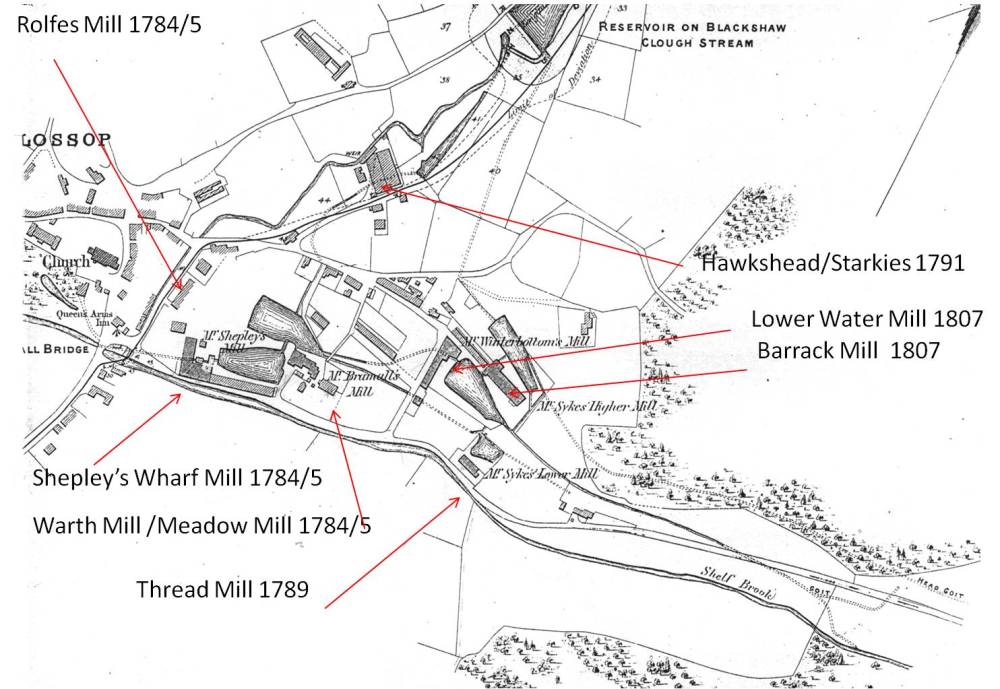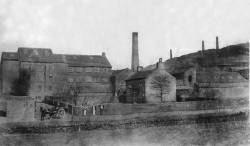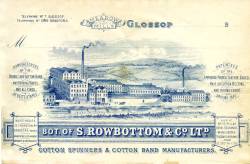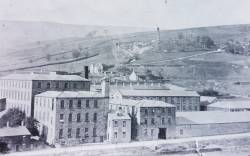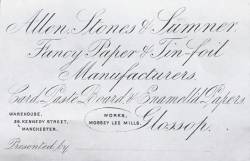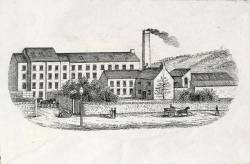| Cross Cliffe Mill. This is another source of confusion for those relying on Hamnett's notes. In an article published in the Glossop Chronicle on 28 November 1913 he described it as “Whitfield Lower Mill” (which was on Glossop Brook, see below). That article goes on to say that the mill was built by John Newton, of Whitfield, who obtained a lease of land 24th November, 1782, he assigned it to Abraham Shaw on the 28th January, 1815, and it eventually came into the possession of of William Hadfield, farmer, of Whitfield, who worked it until his death (see A Hadfield family of Whitfield.). Hamnet then implies (wrongly) that William Hadfield was part of the family which lived at Lees Hall and built Charlestown Mill and Primrose Mill.
An earlier Hamnett article, published on 4 December 1903, says "Cross Cliffe came into the hands of the Hadfield family. The mill was originally known as Hadfield's Mill, then Cross Cliffe Mill, and nick-named "Shoddy Bump Mill." It was burned down on the 2nd June 1868.". That explanation tallies with an indenture dated 31st July 1819, which refers to "all that Cotton Mill or Factory with the Stable or Shippon lately erected and built by the said William Hadfield upon the said close field or parcel of land called the Lower Kiln Croft" - meaning that William Hadfield either built or rebuilt the mill after he bought the land, as recorded in another indenture (which makes no mention of a mill) dated 11th October 1810. A further indenture, dated 24th June 1825, refers to William Hadfield building Cross Cliffe mill. The plan to the right shows the site of the mill in 1825. The will of William Hadfield, signed 10 February 1817, says “I Give and Devise all that my Cotton Mill or Factory situate standing and being at Crosscliffe aforesaid with all and singular the Rights Members and Appurtenances to the same belonging unto my said four sons John Robert James and Joseph Hadfield.”; Codicil 1/10/1819 - “And it is my mind that the improvement I am making to my Cotton Mill at Crosscliffe within Whitfield aforesaid shall be finished by my Executors and the Bargain I have made for the same with Benjamin Wilkinson of Glossop aforesaid Millwright be duly executed”. Probate of the will was granted in February 1820. According to Hamnett, in 1824 the mill was being worked by John Rusby and in 1832 it was John Rusby and Isaac Linney. The indenture of 24th June 1825 identified John Rusby as being tenant at the time, the mill being sold by the four Hadfield brothers to John Rusby and Isaac Linney as recorded in an indenture dated four days later. Hamnett tells us that John Rusby retired in 1840, and it was then worked solely by Isaac Linney. Hamnett also says that in 1846 the owners were Milburn and Roberts but Bagshaw's directory of 1846 lists Isaac Linney as working Cross Cliffe. White's directory of 1862 lists Joseph Brocklehurst & Co. The mill burned down in 1868. The Book of Glossop states "On 24 November 1782 John Newton, described as a labourer of Whitfield, took out a lease from the Lord of the Manor to build a mill at Cross Cliffe. If this mill was completed and came into operation in 1783, it was the first, purpose-built, cotton spinning mill to be built in Glossopdale. It was never large or important and was burnt down in 1868, rebuilt, and demolished in 1902, by which time it was part of the Wood's Mill complex at Howardtown. ". But was this Cross Cliffe Mill or not? It is certainly open to question. When Cross Cliffe Mill is marked on maps it is on the Whitfield side of Hurst Brook, land which was not owned by the Howards but (as supported by the indentures mentioned above) was part of the Bagshaw Estate which included much of Whitfield. If Newton's mill was "part of the Wood's Mill complex at Howardtown" when it was demolished in 1902, perhaps it was the small building(s) shown just north of the bridge on the 1825 plan. |
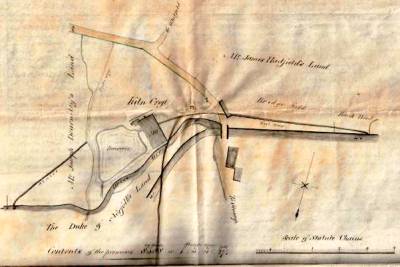 |
